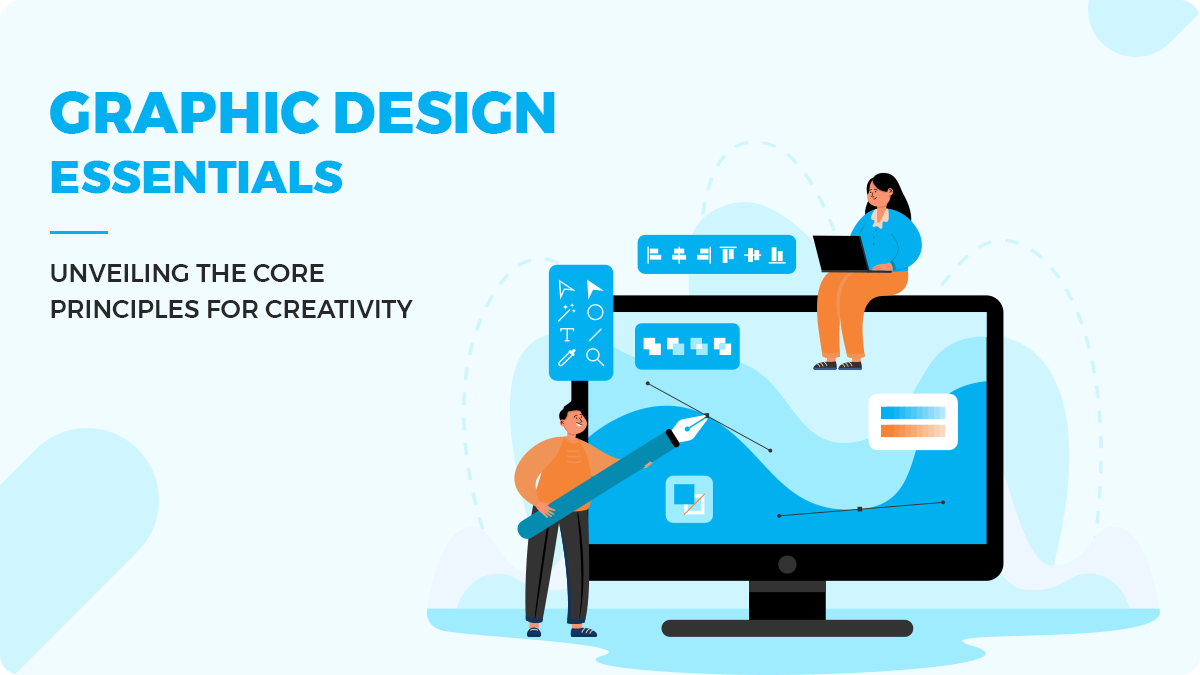Step into the fascinating world of graphic design, where creativity dances hand in hand with functionality to weave stories through visuals! For budding designers, it’s like setting sail on a thrilling adventure, navigating through a vast ocean of techniques and principles, eagerly seeking the compass to craft designs that speak volumes.
Join us on this illuminating journey where we unravel the threads that make up the fabric of graphic design. We’ll equip you with the tools and insights needed to elevate your creative pursuits to new heights.
Let’s dive into the building blocks of every great design, from the delicate dance of balance and contrast to the powerful language spoken by typography and color. Witness how these foundational elements come together to breathe life into artworks that leave a lasting impact on hearts and minds alike.
By immersing yourself in this holistic understanding of graphic design, you’ll unlock the secret to creating visually stunning masterpieces that resonate deeply with your audience. Get ready to embark on an adventure where your imagination knows no bounds!

Read more: User-Centric Design: Meeting the Expectations of Gen Z Audiences
The Power of Graphic Design
Graphic design is a dynamic and influential tool that permeates every aspect of our lives, from the moment we wake up to the advertisements we see, the websites we visit, and the products we buy. It has the remarkable ability to evoke emotions, convey messages, and shape perceptions. Through clever use of visuals and strategic placement of elements, graphic design has the power to captivate, inform, and inspire.
Think about how a well-designed logo can instantly communicate a brand’s identity or how an eye-catching poster can stir up curiosity and excitement. Graphic design is not merely about making things look pretty; it’s about harnessing creativity to solve problems and communicate ideas effectively. In a world inundated with information, good design cuts through the noise and leaves a lasting impression on its audience.
Understanding the Principles
Graphic design is more than just creating visually appealing artwork—it’s about understanding and applying design principles effectively. These fundamental principles serve as the foundation of every successful design, guiding designers in their creative process. By mastering these principles, designers can communicate messages effectively, evoke emotions, and capture the attention of their audience.
From balance to contrast to alignment, each principle plays a crucial role in creating cohesive and impactful designs. Embracing these principles not only enhances the aesthetics of a design but also improves its functionality and clarity. By understanding and applying these fundamental principles with creativity and intention, designers can elevate their work to new heights, leaving a lasting impression on viewers.
Balance: Finding Harmony in Design
In the realm of graphic design, balance is akin to the equilibrium that exists in nature. It involves distributing elements within a composition to create visual stability and harmony.
Imagine a well-designed logo where the elements are strategically placed to create a sense of equilibrium and coherence. Balance allows viewers to navigate through a design effortlessly, appreciating each element’s significance while experiencing an overall feeling of visual satisfaction. Embrace balance in your designs, and witness how it elevate your work to new heights of aesthetic appeal.
Contrast: Making Designs Pop
Contrast is the secret ingredient that adds depth and visual interest to your designs. By juxtaposing elements with differing characteristics, such as light and dark, big and small, or bold and delicate, you can create dynamic compositions that grab attention and guide the viewer’s eye seamlessly through the layout.
Imagine a black-and-white photograph where a single red rose stands out amidst a sea of grayscale tones. The contrast not only highlights the beauty of the rose but also creates a focal point that draws viewers in. In graphic design, using contrast effectively can elevate your work from ordinary to extraordinary, leaving a lasting impression on your audience.
Alignment: Structuring Your Composition
Alignment plays a pivotal role in the visual hierarchy of your design. By aligning elements along a common axis, whether it’s left, right, center, or justified, you create a sense of order and organization. Aligning objects not only enhances the aesthetic appeal but also facilitates easier navigation for the viewer.
Think of alignment as the backbone of your composition; it provides structure and coherence to your design. Embracing alignment allows you to guide the viewer’s eye seamlessly through your layout, ensuring a smooth and intuitive viewing experience. Remember, well-aligned elements convey professionalism and attention to detail, elevating your design from good to exceptional.
Proximity: Creating Meaningful Connections
In graphic design, proximity refers to the principle of grouping related elements together to establish a visual connection. By placing elements close to each other, designers can convey relationships and hierarchy within a composition. This technique helps guide the viewer’s eye and makes information more digestible.
Imagine a well-designed poster where images and text are strategically placed near each other to reinforce a central message. The concept of proximity not only organizes content but also creates a sense of unity and cohesion within the design. Embracing proximity in your designs allows for clearer communication and engages the audience on a deeper level.
Color Theory: Adding Life to Your Designs
Color theory is the art and science of using color to evoke emotion, convey messages, and create visual interest. By understanding the psychology of colors, designers can strategically choose hues that resonate with their audience. Warm colors like reds and oranges can evoke feelings of energy and passion, while cooler tones like blues and greens can create a sense of calmness and tranquility.
Furthermore, exploring color harmonies such as complementary, analogous, or triadic schemes can help designers create visually appealing palettes that enhance the overall impact of their designs. The careful selection and combination of colors can bring life to your designs, making them more engaging and memorable for viewers.
Typography: Choosing the Right Fonts
Typography is the art and practice of arranging type so that it is readable, comprehensible, and aesthetically pleasing when written language is exhibited.
When selecting fonts for your design, consider the personality and tone you want to convey. Serif fonts exude elegance and formality, while sans-serif fonts offer a modern and clean look.
Experiment with different font pairings to create visual hierarchy and contrast in your design. Remember that readability is key; avoid using too many different fonts in one layout as it can lead to confusion. By choosing the right fonts thoughtfully, you can elevate your design and leave a lasting impact on your audience.
Putting It All Together
As a graphic designer, mastering the fundamentals is just the beginning. The true artistry lies in combining these principles seamlessly to create visually stunning and powerful designs. Utilize balance to establish a sense of equilibrium, contrast to draw attention to key elements, alignment for a structured layout, proximity for establishing relationships, color theory for emotional impact, typography for conveying tone and personality, and white space for breathing room.
Remember that each design element plays a crucial role in the overall composition. Embrace creativity and experimentation to find unique ways to integrate these principles into your work. By harmonizing all these aspects effectively, you can elevate your designs from ordinary to extraordinary and leave a lasting impression on your audience.
Conclusion
As we reach the end of this exploration into the fundamental principles of graphic design, it becomes clear that a designer’s journey is one of continuous learning and growth. Embracing these principles not only enhances the visual appeal of your creations but also imbues them with deeper meaning and impact.
Remember, behind every pixel, every stroke, and every font choice lies the opportunity to communicate, inspire, and engage. Let these principles serve as your guiding light as you embark on your creative endeavors, knowing that with each design you craft, you have the power to make a difference in the world.
We are Atlanta’s Most Acknowledged Web Design Company
In today’s digital age, your social media presence is your storefront to the world. USSLLC is dedicated to helping you shine in this digital storefront, offering services that encompass content creation, community management, paid advertising, and more. Our goal is simple: to help you boost your brand’s visibility, grow your audience, and increase your ROI.
So, if you’re looking to make a real impact on social media and unlock the full potential of your brand, look no further than USSLLC, Atlanta’s most acknowledged digital marketing agency. Let’s embark on a journey to elevate your social media game and take your brand to new heights.
Contact us today and witness the transformative power of effective digital marketing. Your success is our priority!
